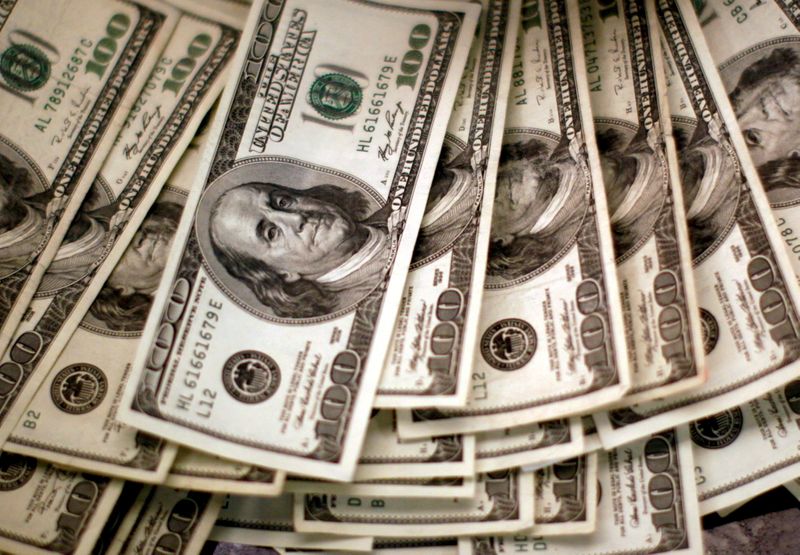By Mike Dolan
LONDON (Reuters) - Whether investors run for the hills or not after the past week's stock market shakeout, the episode provides a glimpse of where to run for cover - and the U.S. dollar came up trumps.
Dollar cash has routinely provided a haven during moments of global funding stress in the past - most recently as the coronavirus pandemic unfolded in March of last year.
The anxiety about a likely debt default by giant real estate firm China Evergrande - and even feared ripple effects across regional property firms, high-yield debt markets and banks - may not be quite on that scale.
But the worries provided enough of a trigger for the steep pullback in world shares this month, and the dollar has been one of the few clear winners during the turbulence.
Although that stock correction has been widely predicted - with a majority in a recent Deutsche Bank (DE:DBKGn) client survey saying they expected a 5-10% correction by year's end - the peak-to-trough plunge in MSCI's all-country index this month almost reached 5% on Monday.
China property nerves are far from over, and financial volatility gauges are their highest in months.
The dollar has performed impressively as a haven, its main trading index gaining more than half a percent over the last week - and it was up almost 1% against gold, more than 1.4% against sterling, almost 7% against Bitcoin.
Rival havens such as Japan's yen and the Swiss franc matched or outstripped that over the seven days just gone - but the dollar is clearly pumped up independently.
Of course, it's not all down to stress. The other big event of the week, the Federal Reserve's latest policymaking meeting, provides alternative fuel for the currency.
And some currency strategists see the dollar now getting a peculiar dual boost.
JPMorgan (NYSE:JPM)'s Paul Meggyesi and team reckon the greenback stands to gain from both corners of the so-called 'dollar smile' at the same time.
That 'smile' describes the observation that the dollar tends to benefit from both extreme stress and tension at one extreme - when highly dollar-borrowed firms around the world scramble for dollar cash and liquidity - and from rapid world growth and risk taking at the other - where U.S. equity outperforms and U.S. rates push higher. In between, it's at its weakest.
"Our confidence has increased that the dollar is on the cusp of a clearer break-out from either end of the dollar-smile, or indeed both ends concurrently," the JPMorgan team wrote.
On the left side of the smile, they see growing angst that world growth has peaked, policy support is being withdrawn, global stocks are overstretched and there are "mounting global tail risks" from China and related geopolitical fears.
On the right side stands the Fed and "U.S. rate-driven exceptionalism", they say. Fed policymakers this week are likely to signal the start of U.S. interest rate hikes from late next year and - crucially - up to six increases through to end-2024.
REAL TIME
Interest-rate support for the dollar is sometimes overlooked by focusing on nominal U.S. bond yields in isolation - especially in a year like this one, when the dollar held firm even as U.S. Treasury yields recoiled during the summer.
A better measure of the dollar's fortunes is often seen in relative real, or inflation-adjusted, bond yields between the U.S. and other major economies or regions.
Having spent most of 2021 in negative territory, for example, the gap in two-year real yields between the U.S. and Germany turned positive last month, and this week the new premium on U.S. rates hit its highest level since June 2020. Ten-year equivalent U.S. rate premia are also at their highest since April.
This real rate view makes sense to those who see inflation expectations and growth potential dominating a currency's fortunes.
All things being equal, a tighter monetary policy today means lower inflation expectations, less erosion of the currency's value over time and a higher currency rate - all assuming growth potential is robust enough to sustain high rates and a higher 'terminal rate' in the tightening cycle.
And that needs to be set against growth and inflation expectations in Europe or Japan.

Morgan Stanley (NYSE:MS)'s Matthew Hornbach and team also see the dollar lifted further by the rising real rate view. And they think this week's Fed meeting could be a big moment.
"The September FOMC may be a key catalyst driving U.S. (real) yields higher, which we expect to boost the dollar broadly," they wrote this week.
(by Mike Dolan, Twitter (NYSE:TWTR): @reutersMikeD; Editing by Kevin Liffey)